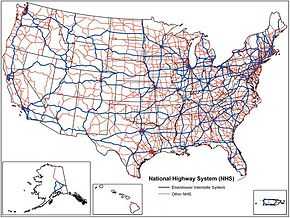National Highway System (United States)
| National Highway System | |
|---|---|
|
System map with Interstate Highways in blue and other components in red | |
| System information | |
| Formed: | November 28, 1995 |
| Length: | 160,955 mi (259,032 km) |
| Highway names | |
| Interstates: | Interstate nn (I-nn) |
| US Routes: | U.S. Highway nn, U.S. Route nn (US nn, US-nn) |
| State: | Varies by state |
| County roads: | County Road nn, County Route nn (CR nn, Co. Rd. nn) |
| System links | |
| |
The National Highway System (NHS) is a network of strategic highways within the United States, including the Interstate Highway System and other roads serving major airports, ports, rail or truck terminals, railway stations, pipeline terminals and other strategic transport facilities. Altogether, it constitutes the largest highway system in the world.
Individual states are encouraged to focus federal funds on improving the efficiency and safety of this network. The roads within the system were identified by the United States Department of Transportation in cooperation with the states, local officials, and metropolitan planning organizations and approved by the United States Congress in 1995.
Legislation
The Intermodal Surface Transportation Efficiency Act of 1991 provided that certain key routes such as the Interstate Highway System, be included.[1]
The National Highway System Designation Act of 1995 (Pub.L. 104–59, 109 Stat. 568) is a United States Act of Congress that was signed into law by President Bill Clinton on November 28, 1995 The legislation designated about 160,955 miles (259,032 km) of roads, including the Interstate Highway System, as the NHS.
Aside from designating the system, the act served several other purposes, including restoring $5.4 billion in funding to state highway departments, giving Congress the power to prioritize highway system projects, repealing all federal speed limit controls, and prohibits the Federal government from requiring States to use federal-aid highway funds to convert existing signs or purchase new signs with metric units.[1]
The act also created a State Infrastructure Bank pilot program. Ten states were chosen in 1996 for this new method of road financing. These banks would lend money like regular banks, with funding coming from the federal government or the private sector, and they would be repaid through such means as highway tolls or taxes. In 1997, 28 more states asked to be part of the program. Ohio was the first state to use a state infrastructure bank to start building a road. An advantage to this method was completing projects faster; state laws and the lack of appropriate projects were potential problems.[2]
Overview

According to the Federal Highway Administration, the 160,000-mile (260,000 km) National Highway System includes roads important to the United States' economy, defense, and mobility, from one or more of the following road networks:[3]
- The Interstate Highway System
- The Strategic Highway Network (STRAHNET) of importance to the United States' strategic defense policy including links from major military installations and this Strategic Highway Network
- Access to 207 airports, 198 ports, 190 rail or truck terminals, 67 Amtrak railway stations, 58 pipeline terminals as well as 82 intercity bus terminals, 307 public transit stations, 37 ferry terminals and 20 multi-purpose passenger terminals[4]
The system includes 4% of the nation's roads, but carries more than 40% of all highway traffic, 75% of heavy truck traffic, and 90% of tourist traffic.[4] All urban areas with a population of over 50,000 and about 90% of America's population live within 5 miles (8.0 km) of the network,[4] which is the longest in the world.[5]
See also
References
- ↑ 1.0 1.1 Staff. "Intermodal Surface Transportation Efficiency Act of 1991". National Transportation Library. Retrieved April 2, 2013.
- ↑ Schienberg, Phyllis (March 6, 1997). "Statement of Phyllis Schienberg, Prospects for Innovation Through Research, Intelligent Transportation Systems, State Infrastructure Banks, and Design-Build Contracting". US Senate Committee on Environment and Public Works. Retrieved July 9, 2012.
- ↑ Natzke, Stefan; Neathery, Mike & Adderly, Kevin (June 20, 2012). "What is the National Highway System?". National Highway System. Federal Highway Administration. Retrieved July 1, 2012.
- ↑ 4.0 4.1 4.2 Slater, Rodney E. (Spring 1996). "The National Highway System: A Commitment to America's Future". Public Roads (Washington, DC: Federal Highway Administration) 59 (4). ISSN 0033-3735. Retrieved July 9, 2012.
- ↑ Cox, Wendell (January 22, 2011). "China Expressway System to Exceed US Interstates". New Geography. Retrieved July 9, 2012.
![]() This article incorporates public domain material from websites or documents of the United States Government.
This article incorporates public domain material from websites or documents of the United States Government.
External links
- STRAHNET description at US military's Transportation Engineering Agency
- STRAHNET article at the GlobalSecurity.org
- Weingroff, Richard F. "Backbone: Creation Of The National Highway System"
- National Highways System Proposed in 1913
